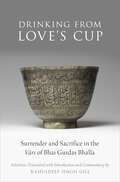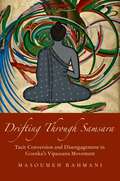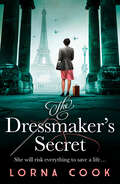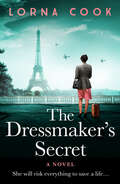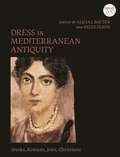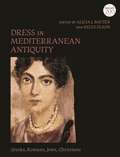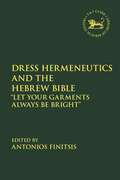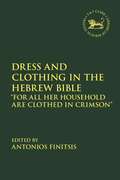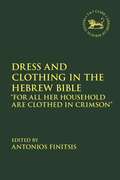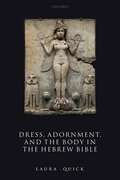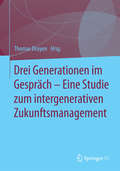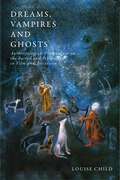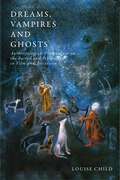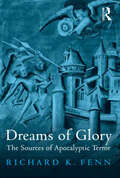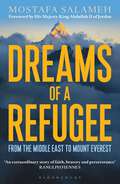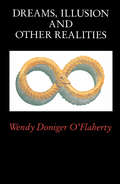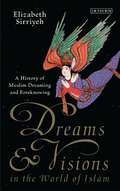- Table View
- List View
Drinking From Love's Cup: Surrender and Sacrifice in the V=ars of Bhai Gurdas Bhalla (AAR Religion in Translation)
by Rahuldeep Singh GillBhai Gurdas Bhalla (d. 1636 CE) is widely considered the most important non-canonical poet in Sikh history, having shaped the theology and ethics of the tradition for centuries. His poems, which offer an authoritative illustration of Sikh life in the early seventeenth century, defined Sikh identity during a tumultuous period of upheaval. In Drinking from Love's Cup, Rahuldeep Gill brings together for the first time a collection of the revered poet's early work, masterfully translated into English, alongside the original Punjabi text. The magic of Gurdas's poetry, says Gill, is the fusion of Islamicate narrative with Indian heroic literature to speak about death, martyrdom, and the spirit's absolution in love. Gill challenges the traditional scholarship surrounding the dates of Gurdas's writing, suggesting that Gurdas wrote his poetry to console the Sikh community when it was in mourning over the execution of the fifth of the Sikh founders, Guru Arjan (d.1606), by agents of the Mughal Empire. Gurdas in his verses immortalized the fifth Guru's role as a martyr and encouraged the faithful to stay involved in the community, resist hegemony, and reinforce Sikh beliefs during the sectarian upheaval. Rhythmic, elegant, and lucid, the poems weave Sikh scripture into the lyrical fabric of Sikh spirituality. Gill brings a contemporary flair to Gurdas's moving stanzas and in his commentary unearths fresh insights about his life and context.
Drinking From Love's Cup: Surrender and Sacrifice in the V=ars of Bhai Gurdas Bhalla (AAR Religion in Translation)
by Rahuldeep Singh GillBhai Gurdas Bhalla (d. 1636 CE) is widely considered the most important non-canonical poet in Sikh history, having shaped the theology and ethics of the tradition for centuries. His poems, which offer an authoritative illustration of Sikh life in the early seventeenth century, defined Sikh identity during a tumultuous period of upheaval. In Drinking from Love's Cup, Rahuldeep Gill brings together for the first time a collection of the revered poet's early work, masterfully translated into English, alongside the original Punjabi text. The magic of Gurdas's poetry, says Gill, is the fusion of Islamicate narrative with Indian heroic literature to speak about death, martyrdom, and the spirit's absolution in love. Gill challenges the traditional scholarship surrounding the dates of Gurdas's writing, suggesting that Gurdas wrote his poetry to console the Sikh community when it was in mourning over the execution of the fifth of the Sikh founders, Guru Arjan (d.1606), by agents of the Mughal Empire. Gurdas in his verses immortalized the fifth Guru's role as a martyr and encouraged the faithful to stay involved in the community, resist hegemony, and reinforce Sikh beliefs during the sectarian upheaval. Rhythmic, elegant, and lucid, the poems weave Sikh scripture into the lyrical fabric of Sikh spirituality. Gill brings a contemporary flair to Gurdas's moving stanzas and in his commentary unearths fresh insights about his life and context.
Drifting through Samsara: Tacit Conversion and Disengagement in Goenka's Vipassana Movement (AAR Academy Series)
by Masoumeh RahmaniIn Drifting Through Samsara, Masoumeh Rahmani provides a fieldwork-based study of Goenka's Vipassana meditation movement in New Zealand. This group is distinguished by its refusal to identify as Buddhist and by a rich rhetorical repertoire for repackaging Theravada Buddhist teachings in pseudo-scientific and secular language. Drawing from qualitative research, the book examines the way the movement's discourse shapes unique processes and narratives of conversion and disengagement. Rahmani argues that conversion to this movement is tacit and paradoxically results in the members' rejection of religious labels and categories including conversion. Tracing the linguistic changes associated with the process of conversion and increased commitment, she outlines three main disengagement pathways: (1) pragmatic leaving, (2) disaffiliation, and (3) deconversion. Pragmatic leavers are individuals who were disengaged prior to developing a commitment. Rahmani argues that the language of these leavers is characterised by pragmatisms, dualistic discourse, and ambivalence, and their post-disengagement involves an active gravitation towards practices with easily accomplished goals. Disaffiliates and deconverts are individuals who disengaged after years of intense commitment to the movement. One of the distinguishing features of disaffiliation narratives is self-doubt resulting from the movement's ambiguous discourse regarding progress. For these people post-disengagement often involves the retrospective adoption of Buddhist identity. Rahmani finds that as a consequence of its linguistic strategies, deconversion is a rare exit pattern from this movement. In general, however, the themes and characteristics of both disaffiliation and deconversion fit the contours of exit from other traditions, even though conversion was tacit in the first place. The book thus questions the normative participant recruitment approach in conversion studies and argues that a simple reliance on the informants' identification with or rejection of religious labels fails to encompass the tonalities of conversion in the contemporary spiritual landscape.
Drifting through Samsara: Tacit Conversion and Disengagement in Goenka's Vipassana Movement (AAR Academy Series)
by Masoumeh RahmaniIn Drifting Through Samsara, Masoumeh Rahmani provides a fieldwork-based study of Goenka's Vipassana meditation movement in New Zealand. This group is distinguished by its refusal to identify as Buddhist and by a rich rhetorical repertoire for repackaging Theravada Buddhist teachings in pseudo-scientific and secular language. Drawing from qualitative research, the book examines the way the movement's discourse shapes unique processes and narratives of conversion and disengagement. Rahmani argues that conversion to this movement is tacit and paradoxically results in the members' rejection of religious labels and categories including conversion. Tracing the linguistic changes associated with the process of conversion and increased commitment, she outlines three main disengagement pathways: (1) pragmatic leaving, (2) disaffiliation, and (3) deconversion. Pragmatic leavers are individuals who were disengaged prior to developing a commitment. Rahmani argues that the language of these leavers is characterised by pragmatisms, dualistic discourse, and ambivalence, and their post-disengagement involves an active gravitation towards practices with easily accomplished goals. Disaffiliates and deconverts are individuals who disengaged after years of intense commitment to the movement. One of the distinguishing features of disaffiliation narratives is self-doubt resulting from the movement's ambiguous discourse regarding progress. For these people post-disengagement often involves the retrospective adoption of Buddhist identity. Rahmani finds that as a consequence of its linguistic strategies, deconversion is a rare exit pattern from this movement. In general, however, the themes and characteristics of both disaffiliation and deconversion fit the contours of exit from other traditions, even though conversion was tacit in the first place. The book thus questions the normative participant recruitment approach in conversion studies and argues that a simple reliance on the informants' identification with or rejection of religious labels fails to encompass the tonalities of conversion in the contemporary spiritual landscape.
The Dressmaker’s Secret
by Lorna Cook‘Extraordinary… Brought history alive on the page… Tense and emotional… Sensitive yet brutal…With the most unexpected end that left me breathless. Wow, just wow… Incredible’ NetGalley Review, ⭐⭐⭐⭐⭐ 1941, Nazi-occupied Paris: In the glamourous Ritz hotel there is a woman with a dangerous secret…
The Dressmaker’s Secret
by Lorna Cook‘Extraordinary… Brought history alive on the page… Tense and emotional… Sensitive yet brutal…With the most unexpected end that left me breathless. Wow, just wow… Incredible’ NetGalley Review, ⭐⭐⭐⭐⭐ 1941, Nazi-occupied Paris: In the glamourous Ritz hotel there is a woman with a dangerous secret…
Dress in Mediterranean Antiquity: Greeks, Romans, Jews, Christians
by Alicia J. Batten and Kelly OlsonInsights from anthropology, religious studies, biblical studies, sociology, classics, and Jewish studies are here combined to provide a cutting-edge guide to dress and religion in the Greco-Roman World and the Mediterranean basin. Clothing, jewellery, cosmetics, and hairstyles are among the many aspects examined to show the variety of functions of dress in communication and in both establishing and defending identity. The volume begins by reviewing how scholars in the fields of classics, anthropology, religious studies, and sociology examine dress. The second section then looks at materials, including depictions of clothing in sculpture and in Egyptian mummy portraits. The third (and largest) part of the book then examines dress in specific contexts, beginning with Greece and Rome and going on to Jewish and Christian dress, with a specific focus on the intersection between dress, clothing and religion. By combining essays from over twenty scholars from different disciplinary backgrounds, the book provides a unique overview of different approaches to and contexts of dress in one volume, leading to a greater understanding of dress both within ancient societies and in the contemporary world.
Dress in Mediterranean Antiquity: Greeks, Romans, Jews, Christians
by Alicia J. Batten Kelly OlsonInsights from anthropology, religious studies, biblical studies, sociology, classics, and Jewish studies are here combined to provide a cutting-edge guide to dress and religion in the Greco-Roman World and the Mediterranean basin. Clothing, jewellery, cosmetics, and hairstyles are among the many aspects examined to show the variety of functions of dress in communication and in both establishing and defending identity. The volume begins by reviewing how scholars in the fields of classics, anthropology, religious studies, and sociology examine dress. The second section then looks at materials, including depictions of clothing in sculpture and in Egyptian mummy portraits. The third (and largest) part of the book then examines dress in specific contexts, beginning with Greece and Rome and going on to Jewish and Christian dress, with a specific focus on the intersection between dress, clothing and religion. By combining essays from over twenty scholars from different disciplinary backgrounds, the book provides a unique overview of different approaches to and contexts of dress in one volume, leading to a greater understanding of dress both within ancient societies and in the contemporary world.
Dress Hermeneutics and the Hebrew Bible: "Let Your Garments Always Be Bright" (The Library of Hebrew Bible/Old Testament Studies)
Antonios Finitsis and contributors continue their examination of dress and clothing in the Hebrew Bible in this collection of illuminating essays. Straddling the divide between the material and the ideological, this book lends shape and texture to topics including social standing, agency, and the motif of cloth and clothing in Esther. Essays also explore the function of dress metaphors in imprecatory Psalms, the symbolic function of headdresses, and the divine clothing of Adam and Eve and the hermeneutics of trauma recovery. Together, the contributors continue to shape scholarly discourse on a growing body of scholarship on dress in the Bible.By turning their analytical gaze to this primary evidence, the contributors are able to reveal the social, psychological, aesthetic, ideological and symbolic meanings of dress in the Hebrew Bible, thereby producing insights into the literature and cultural world of the ancient Near East.
Dress and Clothing in the Hebrew Bible: “For All Her Household Are Clothed in Crimson” (The Library of Hebrew Bible/Old Testament Studies #679)
by Antonios FinitsisBuilt upon the flourishing study of costume, this book analyses sartorial evidence provided both by texts of the ancient Near East and the Hebrew Bible. The essays within lend clarity to the link between material and ideological, examining the tradition of dress, the different types of literature that reference the tradition of garments, and the people for whom such literature was written. The contributors explore sources that illuminate the social, psychological, aesthetic, ideological and symbolic meanings of clothing. The topics covered range from the relationship between clothing, kingship and power, to the symbolic significance of the high priestly regalia and the concept of garments as deception and defiance, while also considering the tendency to omit or ignore descriptions of YHWH's clothing. Following a historical sequence, the essays cross-reference with each other to create a milestone in biblical sartorial study.
Dress and Clothing in the Hebrew Bible: “For All Her Household Are Clothed in Crimson” (The Library of Hebrew Bible/Old Testament Studies)
Built upon the flourishing study of costume, this book analyses sartorial evidence provided both by texts of the ancient Near East and the Hebrew Bible. The essays within lend clarity to the link between material and ideological, examining the tradition of dress, the different types of literature that reference the tradition of garments, and the people for whom such literature was written. The contributors explore sources that illuminate the social, psychological, aesthetic, ideological and symbolic meanings of clothing. The topics covered range from the relationship between clothing, kingship and power, to the symbolic significance of the high priestly regalia and the concept of garments as deception and defiance, while also considering the tendency to omit or ignore descriptions of YHWH's clothing. Following a historical sequence, the essays cross-reference with each other to create a milestone in biblical sartorial study.
Dress, Adornment, and the Body in the Hebrew Bible
by Laura QuickDress, Adornment, and the Body in the Hebrew Bible is the first monograph to treat dress and adornment in biblical literature in the English language. It moves beyond a description of these aspects of ancient life to encompass notions of interpersonal relationships and personhood that underpin practices of dress and adornment. Laura Quick explores the ramifications of body adornment in the biblical world, informed by a methodologically plural approach incorporating material culture alongside philology, textual exegesis, comparative evidence, and sociological models. Drawing upon and synthesizing insights from material culture and texts from across the eastern Mediterranean, the volume reconstructs the social meanings attached to the dressed body in biblical texts. It shows how body adornment can deepen understanding of attitudes towards the self in the ancient world. In Quick's reconstruction of ancient performances of the self, the body serves as the observed centre in which complex ideologies of identity, gender, sexuality, ethnicity, and social status are articulated. The adornment of the body is thus an effective means of non-verbal communication, but one which at the same time is controlled by and dictated through normative social values. Exploring dress, adornment, and the body can therefore open up hitherto unexplored perspectives on these social values in the ancient world, an essential missing piece in understanding the social and cultural world which shaped the Hebrew Bible.
Dress, Adornment, and the Body in the Hebrew Bible
by Laura QuickDress, Adornment, and the Body in the Hebrew Bible is the first monograph to treat dress and adornment in biblical literature in the English language. It moves beyond a description of these aspects of ancient life to encompass notions of interpersonal relationships and personhood that underpin practices of dress and adornment. Laura Quick explores the ramifications of body adornment in the biblical world, informed by a methodologically plural approach incorporating material culture alongside philology, textual exegesis, comparative evidence, and sociological models. Drawing upon and synthesizing insights from material culture and texts from across the eastern Mediterranean, the volume reconstructs the social meanings attached to the dressed body in biblical texts. It shows how body adornment can deepen understanding of attitudes towards the self in the ancient world. In Quick's reconstruction of ancient performances of the self, the body serves as the observed centre in which complex ideologies of identity, gender, sexuality, ethnicity, and social status are articulated. The adornment of the body is thus an effective means of non-verbal communication, but one which at the same time is controlled by and dictated through normative social values. Exploring dress, adornment, and the body can therefore open up hitherto unexplored perspectives on these social values in the ancient world, an essential missing piece in understanding the social and cultural world which shaped the Hebrew Bible.
Drei Generationen im Gespräch – Eine Studie zum intergenerativen Zukunftsmanagement
by Thomas DruyenIm Rahmen der Vermögensforschung haben sich neben den Themen des Reichtums auch das Vermögen des Alters, der Generationen und der Gesundheit als wesentliche Perspektiven herausgestellt. Diese Potenziale sind zugleich wesentlich in der Gestaltung der aktuellen demografischen Veränderungsprozesse. Wissenschaftliche Erkenntnisse zur Dringlichkeit finanzieller, gesundheitlicher und biografischer Vorsorge liegen vor – sie finden jedoch bei den Betroffenen kaum handlungsleitenden Niederschlag. Die vorliegende Studie untersucht anhand intergenerativer Befragungen Perspektiven und Verdrängungsmechanismen in Bezug auf die Zukunftsgestaltung. Mit der gestiegenen Lebenserwartung hat sich die vor jedem liegende Zukunft signifikant verlängert. Umso größer sind die Optionen – und die Notwendigkeit – der vorsorgenden Einwirkung. Dieses Verständnis soll mit der vorliegenden Arbeit befördert werden.
Dreams, Vampires and Ghosts: Anthropological Perspectives on the Sacred and Psychology in Film and Television
by Louise ChildDrawing from social theory and the anthropology of religion, this book explores popular media's fascination with dreams, vampires, demons, ghosts and spirits. Dreams, Vampires and Ghosts does so in the light of contemporary animist studies of societies in which other-than-human persons are not merely a source of entertainment, but a lived social reality. Films and television programs explored include Buffy the Vampire Slayer, Twin Peaks, Bram Stoker's Dracula, Truly Madly Deeply and the films of Hitchcock. Louise Child draws attention to how they both depict and challenge ideas and practices rooted in psychology, while quality television has also facilitated a wave of programming that can explore the interaction of characters in complex social worlds over time. In addition to drawing on theories of film from Freudian psychology and feminist theory, Dreams, Vampires and Ghosts uses approaches derived from a combination of Jungian film studies and anthropology that offer fresh insights for exploring film and television. This book draws attention to explicit and subtle ways in which cinematic narratives engage with myth and religion while at the same time exploring collective dimensions to social and personal life. It advances new developments in genre studies and gender as well as contributing to the growing field of implicit religion using in-depth analyses of communicative dreaming, the shadow, and mystical lovers in film and television.
Dreams, Vampires and Ghosts: Anthropological Perspectives on the Sacred and Psychology in Film and Television
by Louise ChildDrawing from social theory and the anthropology of religion, this book explores popular media's fascination with dreams, vampires, demons, ghosts and spirits. Dreams, Vampires and Ghosts does so in the light of contemporary animist studies of societies in which other-than-human persons are not merely a source of entertainment, but a lived social reality. Films and television programs explored include Buffy the Vampire Slayer, Twin Peaks, Bram Stoker's Dracula, Truly Madly Deeply and the films of Hitchcock. Louise Child draws attention to how they both depict and challenge ideas and practices rooted in psychology, while quality television has also facilitated a wave of programming that can explore the interaction of characters in complex social worlds over time. In addition to drawing on theories of film from Freudian psychology and feminist theory, Dreams, Vampires and Ghosts uses approaches derived from a combination of Jungian film studies and anthropology that offer fresh insights for exploring film and television. This book draws attention to explicit and subtle ways in which cinematic narratives engage with myth and religion while at the same time exploring collective dimensions to social and personal life. It advances new developments in genre studies and gender as well as contributing to the growing field of implicit religion using in-depth analyses of communicative dreaming, the shadow, and mystical lovers in film and television.
Dreams of Glory: The Sources of Apocalyptic Terror
by Richard K. FennIslam, Judaism, and Christianity are engaged not in a 'clash of civilizations' but in a sectarian conflict among branches of a single civilization traditionally steeped in apocalyptic imagery and beliefs. Apocalypticism is a religious luxury that modern civilizations can no longer afford. Many would agree that the propagandists of the Christian Right have raised apocalyptic tensions to a dangerous level since 9/11, but in this book Richard Fenn takes on the mainline church leaders for their role in promoting an apocalyptic view of history. Those who keep apocalyptic beliefs in a respectable place in religious faith and practice must bear their share of responsibility for global terror. It is not only tragic but ironic that the churches have given apocalyptic literature such a respectable place in their sacred texts, because the apocalyptic imagination itself has its sources in non-Biblical literature: the Hellenistic prophesies that gave comfort and courage to the victims of war in the near and middle east from the time of Alexander the Great and Darius. Fenn goes on to hold apocalyptic enthusiasts in the mainline churches, as well as on the Right, responsible for keeping old grievances alive in their demands for a day of final reckoning, and he demonstrates that totalitarian and imperial regimes have made effective use of apocalyptic literature to justify their own violence and to terrify their subjects and enemies.
Dreams of Glory: The Sources of Apocalyptic Terror
by Richard K. FennIslam, Judaism, and Christianity are engaged not in a 'clash of civilizations' but in a sectarian conflict among branches of a single civilization traditionally steeped in apocalyptic imagery and beliefs. Apocalypticism is a religious luxury that modern civilizations can no longer afford. Many would agree that the propagandists of the Christian Right have raised apocalyptic tensions to a dangerous level since 9/11, but in this book Richard Fenn takes on the mainline church leaders for their role in promoting an apocalyptic view of history. Those who keep apocalyptic beliefs in a respectable place in religious faith and practice must bear their share of responsibility for global terror. It is not only tragic but ironic that the churches have given apocalyptic literature such a respectable place in their sacred texts, because the apocalyptic imagination itself has its sources in non-Biblical literature: the Hellenistic prophesies that gave comfort and courage to the victims of war in the near and middle east from the time of Alexander the Great and Darius. Fenn goes on to hold apocalyptic enthusiasts in the mainline churches, as well as on the Right, responsible for keeping old grievances alive in their demands for a day of final reckoning, and he demonstrates that totalitarian and imperial regimes have made effective use of apocalyptic literature to justify their own violence and to terrify their subjects and enemies.
Dreams of a Refugee: From the Middle East to Mount Everest
by Mostafa SalamehBorn in Kuwait to Palestinian refugee parents, a chance meeting led Mostafa Salameh first to London and then to Edinburgh, where he partied to excess, despite having little money. Islam played almost no part in his thinking. Yet it was in Edinburgh that Mostafa had a dream – a profoundly religious experience that would see him renew his faith and change the course of his entire life.One night, Mostafa dreamt that he was standing at the highest point in the world reciting the call to prayer. Despite having no prior mountaineering experience or training, he was inspired to follow his vision and climb Mount Everest. He failed to summit twice before finally reaching the top in 2008 – going on to become the first Jordanian ever to reach the North Pole, and to scale the 'Seven Summits'. In 2016 he reached the South Pole, the first Muslim ever to have done so.Yet exploring is only half the story. Now a devout Muslim, Mostafa is committed to spreading the message of tolerant Islam. A motivational speaker and activist, he is working to turn Arab youth away from radicalisation. Through climbing, he has raised hundreds of thousands of pounds for charity. At a time when positive imagesof Islam can seem few and far between, Dreams of a Refugee tells Mostafa's remarkable story, one of extraordinary faith and positivity. His message for our sceptical times is simple: that each of us has an Everest inside us, which we all can summit if only we dare to dream.
Dreams of a Refugee: From the Middle East to Mount Everest
by Mr Mostafa SalamehBorn in Kuwait to Palestinian refugee parents, a chance meeting led Mostafa Salameh first to London and then to Edinburgh, where he partied to excess, despite having little money. Islam played almost no part in his thinking. Yet it was in Edinburgh that Mostafa had a dream – a profoundly religious experience that would see him renew his faith and change the course of his entire life.One night, Mostafa dreamt that he was standing at the highest point in the world reciting the call to prayer. Despite having no prior mountaineering experience or training, he was inspired to follow his vision and climb Mount Everest. He failed to summit twice before finally reaching the top in 2008 – going on to become the first Jordanian ever to reach the North Pole, and to scale the 'Seven Summits'. In 2016 he reached the South Pole, the first Muslim ever to have done so.Yet exploring is only half the story. Now a devout Muslim, Mostafa is committed to spreading the message of tolerant Islam. A motivational speaker and activist, he is working to turn Arab youth away from radicalisation. Through climbing, he has raised hundreds of thousands of pounds for charity. At a time when positive imagesof Islam can seem few and far between, Dreams of a Refugee tells Mostafa's remarkable story, one of extraordinary faith and positivity. His message for our sceptical times is simple: that each of us has an Everest inside us, which we all can summit if only we dare to dream.
Dreams, Illusion, and Other Realities
by Wendy Doniger O'Flaherty"Wendy Doniger O'Flaherty . . . weaves a brilliant analysis of the complex role of dreams and dreaming in Indian religion, philosophy, literature, and art. . . . In her creative hands, enchanting Indian myths and stories illuminate and are illuminated by authors as different as Aeschylus, Plato, Freud, Jung, Kurl Gödel, Thomas Kuhn, Borges, Picasso, Sir Ernst Gombrich, and many others. This richly suggestive book challenges many of our fundamental assumptions about ourselves and our world."—Mark C. Taylor, New York Times Book Review "Dazzling analysis. . . . The book is firm and convincing once you appreciate its central point, which is that in traditional Hindu thought the dream isn't an accident or byway of experience, but rather the locus of epistemology. In its willful confusion of categories, its teasing readiness to blur the line between the imagined and the real, the dream actually embodies the whole problem of knowledge. . . . [O'Flaherty] wants to make your mental flesh creep, and she succeeds."—Mark Caldwell, Village Voice
Dreams, Illusion, and Other Realities
by Wendy Doniger O'Flaherty"Wendy Doniger O'Flaherty . . . weaves a brilliant analysis of the complex role of dreams and dreaming in Indian religion, philosophy, literature, and art. . . . In her creative hands, enchanting Indian myths and stories illuminate and are illuminated by authors as different as Aeschylus, Plato, Freud, Jung, Kurl Gödel, Thomas Kuhn, Borges, Picasso, Sir Ernst Gombrich, and many others. This richly suggestive book challenges many of our fundamental assumptions about ourselves and our world."—Mark C. Taylor, New York Times Book Review "Dazzling analysis. . . . The book is firm and convincing once you appreciate its central point, which is that in traditional Hindu thought the dream isn't an accident or byway of experience, but rather the locus of epistemology. In its willful confusion of categories, its teasing readiness to blur the line between the imagined and the real, the dream actually embodies the whole problem of knowledge. . . . [O'Flaherty] wants to make your mental flesh creep, and she succeeds."—Mark Caldwell, Village Voice
Dreams, Illusion, and Other Realities
by Wendy Doniger O'Flaherty"Wendy Doniger O'Flaherty . . . weaves a brilliant analysis of the complex role of dreams and dreaming in Indian religion, philosophy, literature, and art. . . . In her creative hands, enchanting Indian myths and stories illuminate and are illuminated by authors as different as Aeschylus, Plato, Freud, Jung, Kurl Gödel, Thomas Kuhn, Borges, Picasso, Sir Ernst Gombrich, and many others. This richly suggestive book challenges many of our fundamental assumptions about ourselves and our world."—Mark C. Taylor, New York Times Book Review "Dazzling analysis. . . . The book is firm and convincing once you appreciate its central point, which is that in traditional Hindu thought the dream isn't an accident or byway of experience, but rather the locus of epistemology. In its willful confusion of categories, its teasing readiness to blur the line between the imagined and the real, the dream actually embodies the whole problem of knowledge. . . . [O'Flaherty] wants to make your mental flesh creep, and she succeeds."—Mark Caldwell, Village Voice
Dreams, Illusion, and Other Realities
by Wendy Doniger O'Flaherty"Wendy Doniger O'Flaherty . . . weaves a brilliant analysis of the complex role of dreams and dreaming in Indian religion, philosophy, literature, and art. . . . In her creative hands, enchanting Indian myths and stories illuminate and are illuminated by authors as different as Aeschylus, Plato, Freud, Jung, Kurl Gödel, Thomas Kuhn, Borges, Picasso, Sir Ernst Gombrich, and many others. This richly suggestive book challenges many of our fundamental assumptions about ourselves and our world."—Mark C. Taylor, New York Times Book Review "Dazzling analysis. . . . The book is firm and convincing once you appreciate its central point, which is that in traditional Hindu thought the dream isn't an accident or byway of experience, but rather the locus of epistemology. In its willful confusion of categories, its teasing readiness to blur the line between the imagined and the real, the dream actually embodies the whole problem of knowledge. . . . [O'Flaherty] wants to make your mental flesh creep, and she succeeds."—Mark Caldwell, Village Voice
Dreams and Visions in the World of Islam: A History of Muslim Dreaming and Foreknowing (Library of Modern Religion)
by Elizabeth SirriyehPeople in Western societies have long been interested in their dreams and what they mean. However, few non-Muslims in the West are likely to seek interpretation of those dreams to help them make life-changing decisions. In the Islamic world the situation is quite different. Dreaming and the import of visions are here of enormous significance, to the degree that many Muslims believe that in their dreams they are receiving divine guidance: for example, on whether or not to accept a marriage proposal, or a new job opportunity. In her authoritative new book, Elizabeth Sirriyeh offers the first concerted history of the rise of dream interpretation in Islamic culture, from medieval times to the present. Central to the book is the figure of the Prophet Muhammad - seen to represent for Muslims the perfect dreamer, visionary and interpreter of dreams. Less benignly, dreams have been exploited in the propaganda of Islamic militants in Afghanistan, and in apocalyptic visions relating to the 9/11 attacks. This timely volume gives an important, fascinating and overlooked subject the exploration it has long deserved.
